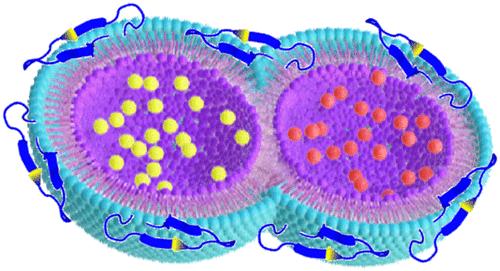冠状蛋白1中含色氨酸-天冬氨酸肽类似物抑制模型膜融合和包膜病毒感染
IF 3.9
2区 化学
Q2 CHEMISTRY, MULTIDISCIPLINARY
引用次数: 0
摘要
膜融合是包膜病毒感染周期的关键步骤,融合抑制剂的开发可能会导致广谱抗病毒药物超越一虫一药模式。我们继续努力设计基于肽的融合抑制剂,通过调节膜物理性质而不是靶向病毒蛋白来阻止融合,我们从冠状蛋白1中设计了一种含有色氨酸-天冬氨酸(WD)的肽类似物mGG-21。冠状蛋白1参与阻止含有吞噬体的活分枝杆菌与溶酶体的融合。与先前设计的抑制活性为20-30%的前辈不同,mGG-21通过增加膜的酰基链排序,在模型膜中显示出约60%的融合孔形成(完全融合)抑制作用,而不考虑膜的胆固醇含量。此外,我们发现mGG-21在细胞模型中抑制流感和基孔肯雅病毒感染而不产生任何毒性。综上所述,我们的发现强调了WD重复序列在设计大范围病毒融合抑制剂中的重要性。本文章由计算机程序翻译,如有差异,请以英文原文为准。

Tryptophan-Aspartic Acid-Containing Peptide Analog from Coronin 1 Inhibits Model Membrane Fusion and Enveloped Viral Infection in Cells
Membrane fusion is a crucial step in the infection cycle of an enveloped virus, and the development of fusion inhibitors could lead to broad-spectrum antivirals beyond the one-bug-one-drug paradigm. In our continued effort to design peptide-based fusion inhibitors that block fusion by modulating membrane physical properties rather than targeting viral proteins, we have designed a tryptophan-aspartic acid (WD)-containing peptide analog, mGG-21, from coronin 1. Coronin 1 has been implicated in preventing the fusion of live mycobacteria containing phagosomes with lysosomes. mGG-21 displays around 60% inhibition in fusion pore formation (complete fusion) in model membranes by likely increasing the acyl chain ordering of the membrane, regardless of the cholesterol content of the membrane, unlike its previously designed predecessors with 20–30% inhibition activity. Further, we show that mGG-21 inhibits Influenza and Chikungunya virus infection in cellular models without exerting any toxicity. Taken together, our findings underscore the importance of WD repeats in the design of broad-range viral fusion inhibitors.
求助全文
通过发布文献求助,成功后即可免费获取论文全文。
去求助
来源期刊

Langmuir
化学-材料科学:综合
CiteScore
6.50
自引率
10.30%
发文量
1464
审稿时长
2.1 months
期刊介绍:
Langmuir is an interdisciplinary journal publishing articles in the following subject categories:
Colloids: surfactants and self-assembly, dispersions, emulsions, foams
Interfaces: adsorption, reactions, films, forces
Biological Interfaces: biocolloids, biomolecular and biomimetic materials
Materials: nano- and mesostructured materials, polymers, gels, liquid crystals
Electrochemistry: interfacial charge transfer, charge transport, electrocatalysis, electrokinetic phenomena, bioelectrochemistry
Devices and Applications: sensors, fluidics, patterning, catalysis, photonic crystals
However, when high-impact, original work is submitted that does not fit within the above categories, decisions to accept or decline such papers will be based on one criteria: What Would Irving Do?
Langmuir ranks #2 in citations out of 136 journals in the category of Physical Chemistry with 113,157 total citations. The journal received an Impact Factor of 4.384*.
This journal is also indexed in the categories of Materials Science (ranked #1) and Multidisciplinary Chemistry (ranked #5).
 求助内容:
求助内容: 应助结果提醒方式:
应助结果提醒方式:


